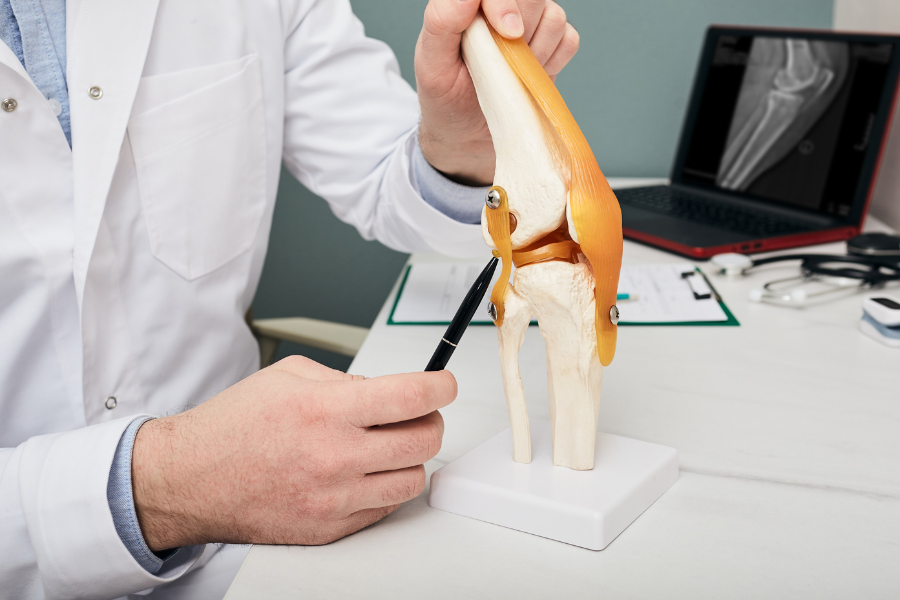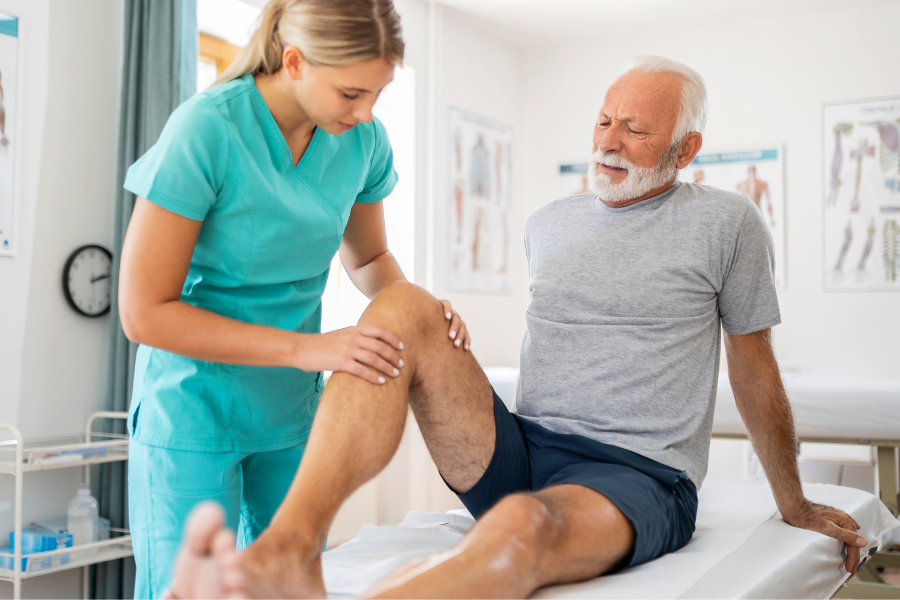 What is Knee Arthritis?
What is Knee Arthritis?- Symptoms of Knee Arthritis
- How to Treat Arthritis in the Knee
- How to Prevent Knee Arthritis
- Can You Still Have Arthritis After Knee Replacement?
Have you experienced pain when bending or moving your knees? You could be experiencing symptoms of something more chronic. Knee arthritis occurs when the cushioning cartilage in the joint wears down, making the knee stiff and painful with certain movements. It affects about 1 in 4 adults after the age of 40.
Living with knee arthritis can be frustrating, but at Louisville Hip & Knee Institute, we are committed to helping you live pain-free. Take a deeper look into symptoms of knee arthritis, its causes, symptoms, treatment options, and what to expect after a knee replacement.
What is Knee Arthritis?
Arthritis of the knee is a medical condition that involves inflammation and deterioration of the knee joint. The knee joint is where the thigh bone (femur) meets the shinbone (tibia) and the kneecap (patella). It is one of the most commonly affected joints for arthritis.
Several types of arthritis can affect the knee joint, including:
- Osteoarthritis: This is the most common form of knee arthritis. It occurs when the protective cartilage that cushions the ends of the bones in the knee joint wears down over time. Osteoarthritis typically develops as people age or due to wear and tear on the knee joint.
- Rheumatoid Arthritis: Rheumatoid arthritis is an autoimmune disease affecting multiple joints, including the knee. It occurs when the body’s immune system attacks the synovium (the lining of the joint capsule), leading to inflammation, pain, and, eventually, joint damage.
- Post-Traumatic Arthritis: This type of arthritis can develop following a knee injury or trauma, such as a fracture or ligament tear. The initial injury can lead to joint instability and, over time, cause arthritis in the affected knee.
- Gouty Arthritis: Gout is a form of arthritis caused by the buildup of uric acid crystals in the joints, including the knee. When uric acid levels in the blood become too high, it can lead to painful gout attacks in the knee joint.
Learn more about arthritis, including statistics and how to manage pain, with our infographic “What to Know About Arthritis.”
Symptoms of Knee Arthritis
Living with knee arthritis can be challenging, as it often brings a range of unpleasant symptoms, including:
- Pain: Persistent discomfort, aches, or shooting pains, especially during movement or weight-bearing activities.
- Swelling: Swollen and inflamed knees that may feel warm to the touch.
- Stiffness: Difficulty bending or straightening the knee, particularly after long rest periods.
- Cracking or Popping: Audible sounds when moving the knee.
- Limited Mobility: Difficulty walking, climbing stairs, or performing daily activities.
If you experience these symptoms, see a doctor, specifically a knee specialist, who understands how arthritis differentiates from other disorders and injuries. You may have developed arthritis over time, so it’s helpful to get a diagnosis to understand what type of arthritis is causing the pain.
What Causes Knee Arthritis?
Several factors can contribute to the development of knee arthritis:
- Age: The risk of developing knee arthritis increases with age. As people age, the cartilage in their knee joints can wear down, leading to arthritis.
- Genetics: Family history can play a role in the development of knee arthritis. If you have close relatives with arthritis, you may be at a higher risk.
- Gender: Knee arthritis is more common in women than men, especially after menopause. Hormonal changes may contribute to this difference.

- Obesity: Excess body weight puts extra stress on the knee joints. The added pressure can accelerate the breakdown of cartilage and increase the risk of knee arthritis.
- Joint injuries: Previous injuries to the knee, such as ligament tears or fractures, can damage the common structures and increase the likelihood of developing arthritis later in life.
- Overuse or repetitive stress: Activities that involve repetitive movements of the knee, such as kneeling, squatting, or participating in high-impact sports, can lead to wear and tear on the joint and increase the risk of arthritis.
- Misalignment or poor joint mechanics: Problems with the alignment of the knee joint or abnormal joint mechanics can lead to uneven wear and tear on the cartilage, contributing to arthritis.
- Inflammatory conditions: Certain autoimmune or inflammatory conditions, such as rheumatoid arthritis, can affect the knee joint and lead to arthritis.
- Infection: Infections in the knee joint can damage the joint structures and lead to arthritis if not treated promptly.
- Other medical conditions: Gout or pseudogout can cause crystals to accumulate in the knee joint, leading to inflammation and arthritis.
It’s important to note that while these factors can increase the risk of developing knee arthritis, the exact cause can vary from person to person. Additionally, some individuals may develop knee arthritis without any risk factors.
How to Treat Arthritis in the Knee
The management of knee arthritis typically involves a combination of lifestyle changes, medication, physical therapy, and, in some cases, surgery.
Here are some common approaches to treating knee arthritis:
Medications
Some different medications for pain and antirheumatic can help. Here are a few that might be prescribed:
- Pain relievers: Over-the-counter pain relievers like acetaminophen or nonsteroidal anti-inflammatory drugs (NSAIDs) can help manage pain and inflammation.
- Prescription medications: In some cases, your doctor may prescribe stronger pain medications or disease-modifying antirheumatic drugs (DMARDs) to slow the progression of the disease.
Physical Therapy
A physical therapist can develop an exercise program to strengthen the muscles around your knee, improve joint mobility, and reduce pain. This can help improve your overall knee function.
Lifestyle Modifications
If you want to help your knee arthritis and inflammation heal faster, these are some ways to support your body.
- Weight management: Maintaining a healthy weight can reduce the stress on your knee joints.
- Low-impact exercises: Activities like swimming, cycling, and gentle stretching can be more accessible on the knee joint and help maintain flexibility and strength.
- Assistive devices: Using a cane, brace, or knee support can help reduce strain on the knee joint.
Injections
Your doctor may talk to you about different injections that can help with inflammatory arthritis.
- Corticosteroid injections: These can provide short-term relief from pain and inflammation.
- Hyaluronic acid injections: Also known as viscosupplementation, these injections can lubricate the knee joint and reduce pain.
Surgery
When conservative treatments are ineffective, your doctor may recommend surgical options, such as:
- Arthroscopy: A minimally invasive procedure to clean out damaged tissue or repair minor joint damage.
- Partial or total knee replacement: In more severe cases, a surgeon may replace part or all of the knee joint with artificial components.
Alternative Therapies
Some people find relief from knee arthritis symptoms through complementary treatments like acupuncture, chiropractic care, or dietary supplements. Be sure to discuss these options with your healthcare provider.
Pain Management Techniques
Heat and cold therapy, as well as the use of assistive devices like knee braces, can help manage pain and improve mobility.
How to Prevent Knee Arthritis
Preventing knee arthritis involves maintaining a healthy lifestyle and taking precautions to reduce stress on your knees. However, this condition usually begins as we age and cartilage wears down. Here are some tips that may help reduce the risk of knee arthritis:
- Maintain a Healthy Weight: Excess weight can strain your knees, but maintaining a healthy weight can reduce the risk of knee arthritis.
- Regular Exercise: Engage in low-impact exercises to strengthen the muscles around your knees. Activities like swimming, cycling, and walking can help without putting too much stress on the joints.
- Proper Posture and Body Mechanics: Practice good posture and proper body mechanics when doing physical activities or lifting objects to avoid unnecessary strain on your knees.
- Protective Gear: If you participate in sports or activities involving a knee injury risk, wear appropriate protective gear, such as knee braces.
- Balanced Diet: A balanced diet rich in fruits, vegetables, whole grains, and omega-3 fatty acids can help maintain overall joint health.
- Avoid Overuse: Avoid activities that put repetitive stress on your knees for extended periods.
- Regular Check-ups: Regular check-ups with your healthcare provider to monitor your joint health and address any concerns early on.
Can You Still Have Arthritis After Knee Replacement?
A common misconception is that knee replacement surgery permanently solves arthritis. While knee replacement can significantly improve your quality of life by relieving pain and restoring joint function, it’s essential to understand that it may not eliminate arthritis. The prosthetic knee joint is durable but can still be affected by wear and tear or infection. Regular follow-up appointments with your orthopedic surgeon are essential to monitor the condition and address potential issues.
Living with inflammatory knee arthritis can be challenging, but you don’t have to endure the pain and discomfort alone. At the Louisville Hip & Knee Institute, we can help you regain your active lifestyle and provide personalized treatment options.
If you or a loved one suffers from knee arthritis, don’t hesitate to take the next step. Schedule an appointment today, and let’s find the best treatment plan for you.

